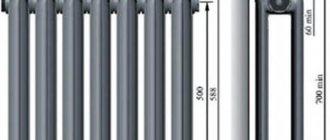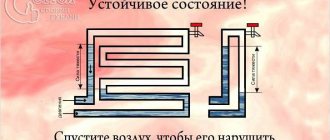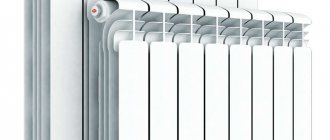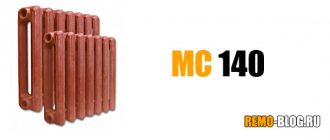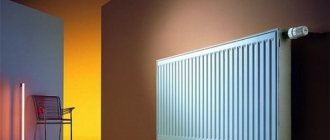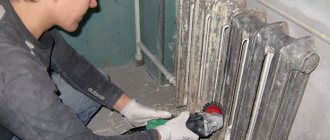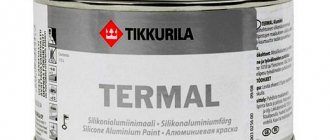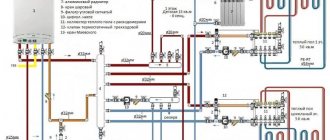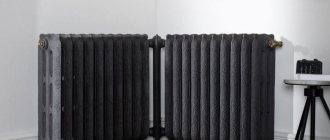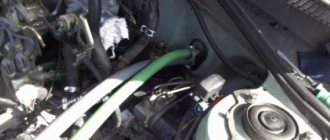Average service life of radiators of different types
| Battery type | Resistance to water hammer | Corrosion resistance | Duration of use, years. | ||||
| Steel | weak | low | 15-20 | ||||
| Aluminum | average | high (if additional protection is available) | 20-25 | ||||
| Bimetallic | high | high | 25-30 | ||||
| Cast iron | average | high | 25-35 | ||||
In addition to the quality of the raw materials used and compliance with the technological process regulations, other factors also influence the lifespan of radiators. Among them are:
- correct installation;
- regularity of maintenance;
- working pressure value;
- maximum permissible temperature in heating networks;
- composition and quality of coolant transported through pipes.
The operating pressure depends on the heating characteristics. In autonomous networks, which are used to maintain a comfortable temperature in the premises of private houses, it varies from 3 to 5 atm. The pressure in central heating systems of multi-storey buildings is about 8-16 atm. To ensure long-term use of radiators, their operating pressure must exceed the same parameter in the network by at least 2 atm. The composition of the coolant also differs. In autonomous networks, antifreeze solutions can be used, and water for central communications is usually subjected to chemical treatment.
In addition, the duration of use of batteries installed in apartments with central heating is negatively affected by water hammer in the pipeline. They occur due to pressure changes and often occur when utilities are started at the beginning of the heating season. Since different materials are used for the production of radiators, their level of resistance to external influences, reliability and durability differ significantly. Some manufacturers achieve improved technical parameters and increased service life by introducing new technologies and methods of metal processing.
Washing cast iron batteries
It is difficult to imagine the quality of hot water in heating systems of the late 19th and early 20th centuries, but everyone knows that the current coolant is contaminated with chemical impurities and rusty turbidity. When it dries out during the off-season period, the rusty suspension settles on the inner walls of the pipes and radiator cavities, clogging the flow area. Over the course of a year, the layer grows up to several millimeters. Heat transfer power is reduced by almost 50%.
Over time, the unhindered circulation of hot coolant becomes increasingly difficult due to an increase in hydraulic resistance in a narrowed flow section. Therefore, removing accumulated dirt from the radiator is the main type of maintenance of radiators.
- chemical;
- hydropneumatic;
- conventional hydraulic;
- flushing and disassembling the radiator.
The first three methods are intended for cleaning communications of the central heating system by housing and communal services, have a regulated frequency and require special material support. Washing disassembled radiator sections is used in everyday life, when the radiator is disassembled on its own and the internal volume of the sections is thoroughly cleaned of accumulated dirt.
It is not at all necessary to hire an abstract plumber, Uncle Vasya, who knows how to remove a cast-iron heating radiator and then disassemble and wash it. After making sure that there is no water in the riser, it is not at all difficult to disconnect the riser pipe at the joints with your own hands and remove the battery from the mounting hooks. The removed radiator is washed from the hose with a stream of water directed in the direction opposite to the direction of coolant flow. It is necessary to rinse until clear water flows from the radiator, free of rust and dirt.
Another method of flushing is to fill the radiator with hot water containing a cleaning agent such as caustic soda, close the plugs and leave for an hour. Then knock on the walls of the radiator with a wooden hammer, shake the battery, you can turn it from side to side several times. The rusty deposits should flake off and go away with the poured water.
It is important!
Cast iron is a brittle material, so tapping the walls must be done with a wooden hammer. The walls of the radiator may be damaged by blows from a metal hammer. Hidden cracks are stress concentrators, which, when the pressure in the network increases, can destroy the battery.
The procedure itself, how to disassemble a cast iron sectional radiator, does not have any approved guidelines for its execution, so all actions
Characteristics of steel radiators
The least durable heating devices include steel radiators, whose service life ranges from 15 to 20 years. They are characterized by low resistance to corrosion, leading to deformation and destruction of products. Heating devices made from low-quality metal are especially susceptible to rust.
Radiators made of stamped steel sheets can withstand pressure of no more than 8.5 atm. Exceeding this parameter contributes to the destruction of welded joints and failure of products. Damage can also occur as a result of water hammer, so it is recommended to install steel batteries in autonomous networks that are used to heat private houses.
Features of aluminum batteries
Aluminum radiators are also used in heating systems that are not connected to central communications. Operating such batteries in apartment buildings can damage the metal. They are characterized by the following:
- good heat dissipation;
- light weight;
- the ability to select a heating device with the required number of sections;
- variety of shapes and sizes;
- heat distribution by convection flow, which is created due to the shape of the ribs.
However, aluminum radiators are not able to withstand high pressure: their maximum is 8 atmospheres in the current mode and 16 during pressure testing. They are characterized by low resistance to hydraulic shocks and are sensitive to the composition of the coolant. With an increased level of acidity in the working environment, there is a high probability of corrosion. It can also occur when there is no water in the system, so it is not advisable to drain it.
By controlling the pH level of the coolant and maintaining the pressure within the specified limits, aluminum batteries will last about 20 years. Installing products in central networks is not advisable because they will soon need to be replaced, which will lead to additional costs.
Selecting a radiator: truisms
There are a whole host of technical indicators and criteria that must be used when choosing thermal equipment. Heat dissipation is the first thing you should pay attention to. A table of the main technical characteristics of cast iron heating radiators is indicated by the manufacturer for each type of product:
- section size;
- operating pressure;
- thermal power;
- heating area of one section;
- volume of water in the section;
- section weight.
Such expanded information will allow you to choose the most suitable heating device for certain conditions, for example, konner cast iron heating radiators.
Absolutely all cast iron heating radiators, reviews and characteristics of which can be read on forums, are united in one thing - reliable, durable and affordable heating equipment.
Durability of cast iron radiators
The most durable heating devices are cast iron, which usually perform their functions for 25-35 years. The service life of some products can reach up to 50 years. This service life is due to the following characteristics:
- resistance to corrosion;
- low sensitivity to coolant quality;
- ability to maintain its parameters at temperatures reaching 130 °C.
Due to the properties of the material, cast iron radiators cool more slowly than similar products made of aluminum or steel. However, they are not designed for pressures above 9 atmospheres and therefore cannot be used when installing central communications. In addition, cast iron is a brittle metal and is susceptible to destruction under the influence of hydraulic shocks. Heating devices made of cast iron can last as long as possible if protection against sudden pressure changes is provided, and its value in normal mode does not exceed permissible values.
We correctly calculate the power of cast iron radiators
Manufacturers do not indicate the power of the entire battery, but only one section, therefore, everyone has to determine the required number of sections for their own territorial area independently.
In order to correctly calculate the numerical value of the power of cast iron heating radiators, it is necessary to take into account that its value is affected by:
- dimensions of the room area;
- presence of double-glazed windows;
- coolant temperature.
The rule for calculation is simple: for every square meter there should be 120 watts of power. While each section has a radiator power of 160 watts. Therefore, the number of sections for a cast iron battery must be greater than, for example, for a steel or aluminum battery.
The rule is suitable for rooms that have a window and an external exterior wall. For a room with high ceilings, the heat output should be greater. For a room with windows equipped with double-glazed windows, 15% should be subtracted from the obtained value.
To correctly calculate the number of sections, you should start from the temperature of the coolant itself. The optimal temperature for it is 70 degrees. When the temperature has lower heat indicators, it means that for every ten degrees one should add from 10 to 15% of the total heat power.
Service life of bimetallic batteries
Bimetallic models are less durable than their cast iron counterparts: their service life averages from 25 to 30 years, and manufacturers usually provide warranties for 10 years. This service life is achieved due to the following factors:
- good strength indicators, which are obtained due to the design features, which include the presence of a steel core;
- ability to withstand at least 20 atmospheres;
- high level of resistance to hydraulic shocks.
Bimetallic radiators are characterized by good heat dissipation, aesthetic appeal and low weight. The availability of products with different axial distances provides wide installation options. They are resistant to corrosion and are not sensitive to the composition of the coolant.
Bimetallic heating devices are able to maintain their functions for a long time both in autonomous networks and in centralized systems of high-rise buildings. However, it is more rational to use products when laying communications in multi-apartment buildings, where they show maximum efficiency throughout their entire service life.
Disassembly and disassembly of cast iron battery
The end caps are unscrewed, and then the nipples between the sections. Often the fittings and sections become very stuck, and you have to apply force to make the stuck fitting turn. When the radiator appears in the form of simple cast iron parts, each of them is cleaned of rusty deposits by any available mechanical method. Cast iron is not afraid of scratches, so you can chip or beat off stubborn pieces of hardened dirt.
When the radiator is temporarily removed from the heating system, it is necessary to use this situation to supplement the battery with additional sections. Calculating cast iron heating radiators to determine the optimal number of sections is simple. We use the required value of 100 W to heat 1 square. meters of housing and the minimum heat transfer of the section indicated in the passport of the cast iron “accordion” is 125 W.
For a large room of 24 square meters. meters you will need at least:
24 x 100 = 2400 W of thermal energy.
It can be obtained from:
2400 / 125 = 19.2 pieces of sections.
We round up with a margin. This means that at least 20 sections are needed, which is equivalent to two ten-section cast iron batteries.
After determining the required number of sections, it remains to decide how to increase the batteries in accordance with the size of the windows and their location. The radiators are unified for any type of pipe routing to the riser, having two end points for connection in the design. Nipples with paronite or rubber gaskets are screwed into the threaded inlets, cleaned of rust and dirt, and pressed for connection with the next section.
Washing batteries, carried out every two to three years in this simple way, will help extend the life of cast iron batteries, which, as mentioned above, with basic maintenance can last more than half a century.
The normal operation of heating radiators for an apartment in a multi-storey building depends on a number of important factors, where the duration of use, determined by each specific manufacturer, plays an important role. Based on the material of production, various batteries can last from 15 to 35 years.
Considering that this is an investment in the long term, when choosing devices to equip an apartment heating system, you should ask how long a certain type of device lasts and what can affect its durability!
Lammin Product Benefits
Lammin sells bimetallic and aluminum radiators of the Eco and Premium series of its own production. The warranty period for the first products is 7 years, and for the second - 10. They meet the requirements of European standards and are adapted for use in Russian conditions. High quality heating devices is achieved through the use of modern production lines and the introduction of special developments.
Bimetallic batteries are ideal for heating offices, apartments in multi-storey buildings and industrial premises. They are insensitive to the composition of the coolant, since the design does not allow contact between aluminum and the medium transported through the pipes. Aluminum models are produced using injection molding from a unique alloy and are used for the installation of autonomous heating networks in private homes and country cottages. They are characterized by increased strength and reliability. A protective coating on the inner surface protects the metal from corrosion.
Repair of heating batteries in an apartment
The main question that arises when there are problems with heating in an apartment is where to go and who will pay for the repairs.
Since problems with radiators, especially outdated ones, happen frequently, so do legal “skirmishes” between residents and utility services. Representatives of the housing office each time claimed that they were in charge only of that part of the heating system that was located in the entrance, while the owners of the affected apartments proved the opposite.
This was the case until the law on communal property was adopted, according to which the entire heating system, even that located in private apartments, is under the jurisdiction of public utilities. The specialists of the organization that provides heat ensure that all radiators work efficiently , and the residents of the house contribute money monthly for major repairs of the heating system in an apartment building, if necessary.
The heating in the apartment is not working, who should I call? For any problems with the system, you need to call the appropriate service and its representatives will fix them free of charge.
This does not apply to cases where the heating is in order, and the residents decide to change the radiators to a newer model. In this case, the entire replacement occurs at the expense of the apartment owners.
When a heating radiator leaks in an apartment, this is caused by the following reasons:
- Their service life had long expired, and a breakthrough was only a matter of time.
- They could not withstand the pressure during the summer maintenance work. This may be due to the wrong choice of heating batteries.
To independently fix a broken heating battery in an apartment, which is usually not recommended, you can use epoxy resin-based glue, but only as a temporary solution to the problem until the emergency service arrives.
If the cause of the leak is a dried out gasket, then you can replace it yourself, provided that there is no water in the system. If the accident occurred during the heating season, then in order to avoid burns it is better not to do anything on your own.
As can be seen from the above, in order not to wait for extreme cases, you need to monitor the heating system, and if it does not heat, makes strange sounds or leaks, then you should call the housing office or emergency service.
If the radiators have long expired, there is no need to check them for durability, but replace them with a more modern model that matches the parameters.
netholodu.com

